9.1 Seed Morphology
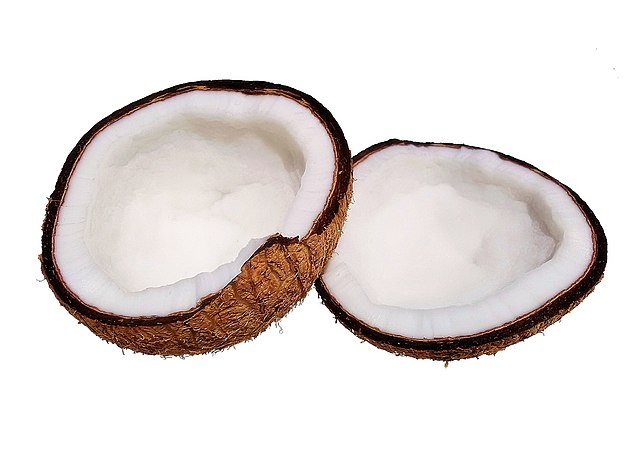 Why a coconut? Because inside the coconut’s fibrous husk is a seed (image: Coconut. Filo gèn. CC BY-SA 4.0).
Why a coconut? Because inside the coconut’s fibrous husk is a seed (image: Coconut. Filo gèn. CC BY-SA 4.0).
Learning objectives
By the end of this lesson you will be able to:
- List three functions of a seed and name the seed part that has that function.
- Identify the parts of the embryo and the structures they become.
- List the types of nutrients that are stored in seeds.
- Describe the differences between the tissues that provide protection for the seed.
Seeds and diversity
To review, the two fundamental ways of propagating plants and how they differ in their outcomes are sexual reproduction through seeds or spores, and asexual or vegetative reproduction through manipulation of various plant parts, including cuttings from leaves, roots, and stems, or grafting.
Asexual reproduction, also called vegetative propagation, normally results in progeny (offspring) that are an exact genetic copy of the parent plant that donates the vegetative parts used in propagation. All of the progeny propagated from the same plant contain the same genes as the parent plant, and the progeny are also identical to each other. Differences among progeny or between parent and progeny may arise as a result of mutation, but this is rare. More likely, any differences among plants that have been asexually propagated from the same parent occur because the growing environment differs from plant to plant in some important way (fertility, water, light). The way the plant looks and performs in a particular environment is called its phenotype. The collection of genes the plant contains is called its genotype. Vegetative propagation results in identical genotypes, but two plants with identical genotypes may have different phenotypes if they are grown in contrasting environments.
Sexual reproduction in weedy, native, or undomesticated plants typically results in seeds that are genetically different from either parent, and in progeny that are all genetically different from one another. Sexual reproduction in domesticated plants can also result in genetically diverse seed, but for those domesticated plants that are highly inbred, like peas, beans, and cereals other than corn (like barley, wheat, oats, and rice), sexual reproduction can also result in seeds that are genetically identical to the parent. For now, remember that sexual reproduction means that a seed is formed as a result of fusion of a sperm and egg cell, and that there is the potential for progeny to differ from the parent(s).
Sexual reproduction, and the genetically variable progeny that result, give a plant species a great deal of flexibility to adapt to new habitats and environmental conditions. Some progeny might be extremely well adapted to new niches and can thrive there, while some will not fit and will not survive and reproduce. To assist the species in spreading, the seeds of the plants that successfully reproduce often have strategies for dispersal away from the parent plant. This spread the species to diverse locations and new ecological niches, and also reduces the likelihood of too many plants of the same species competing with each other in a limited space for the same scarce resources.
Seed formation is normally assumed to be the result of sexual reproduction rather than vegetative propagation. In rare cases, however, an embryo can develop solely from maternal tissue with no fusion of egg and sperm. This is called apomixis. Apomixis is really a form of asexual reproduction disguised as sexual reproduction. The process results in a seed, but the embryo in the seed isn’t the result of sex — the fusion of male and female gametes. All of the progeny are identical to the parent because the embryo is actually a clone (genetically identical offspring) of the plant on which the seed is produced. Kentucky bluegrass reproduces this way, as does dandelion. It is ironic that our lawns are often inhabited by two apomictic species … the Kentucky bluegrass we struggle to grow, and the dandelions many homeowners go to great extremes to eradicate.
Basic seed morphology
Seeds have three main functions:
Propagation of the plant
This is accomplished by the embryo, which is the nascent (new, young) plant resulting from the combination of genes from the male sperm, transmitted by the pollen, to the female egg, held in an ovule in the ovary. The embryo has an axis with one end differentiating into the shoot and the other into the root.
Nutrient storage
Two types of structures can store nutrients in the seed — the cotyledon and the endosperm. The nutrients fuel growth of the embryo.
Protection
The embryo and nutrient source need a tough covering for protection from the environment and predators, and this is typically, but not always, provided by a structure called the seed coat (sometimes called the testa).
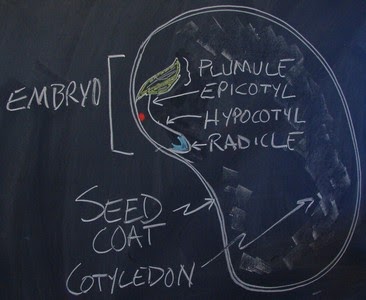
The drawing above shows a simple cross section of a kidney bean seed (a dicot, but only showing one cotyledon), illustrating these three functions. The kidney-shaped part is the outline of the cotyledon, the main mass of the bean seed and the site of stored nutrients. Sandwiched between the cotyledon halves is the embryo, which is the nascent plant. On the outside of the cotyledon is a thin layer that is the protective seed coat. The kidney bean seeds we see in the grocery store have a seed coat that typically has a light or dark maroon color. In peanuts, the different structures are easy to see when you pull the two cotyledons apart.
First function: Propagation of the plant by the embryo
In flowering plants the embryo is normally the result of fusion of egg and sperm. The egg is held within an ovule, which in turn is held within the ovary, which can hold several ovules, depending on the species. The egg is typically fertilized by sperm from pollen. The maturing ovule develops within the ovary of the maternal plant.

A mature seed has an embryo with a linear arrangement of parts. This arrangement is called the embryo axis. The drawing above shows the embryo axis from the kidney bean, straightened out to show the individual structures.
- Embryo axis — the embryonic root and shoot
- Parts making up the shoot tissue of the embryo axis:
- Plumule — the first true leaves of the plant that you can sometimes see already attached to the embryo. These leaves will emerge from the seed, rise above the soil surface, and start to collect energy from the sun.
- Point of attachment — the spot shown in red in the diagram (it’s not red on a real embryo) on the embryo axis where the cotyledon attaches. The cotyledon is attached to the embryo, and is actually part of the embryo. In the case of the bean, the cotyledon is a nutrient storage organ and the nutrients flow to the embryo through the point of attachment of the cotyledon to the embryo axis.
- Epicotyl — the part of the embryo axis that is above (epi-) the point of attachment of the cotyledons
- Hypocotyl — the part of the embryo axis that is shoot tissue below (hypo-) the point of attachment of the cotyledons, but above the radical. The hypocotyl is the part of the shoot between the attachment of the cotyledon and the start of the root (radicle).
- Part making up the root tissue of the embryo axis:
- Radicle — the embryonic root tissue
At the tip of the epicotyl is the shoot apical meristem that will produce new nodes and internodes. If you’re counting nodes on the embryonic axis, the first node on the stem starting from the point of transition of root to shoot is the point where the cotyledons attach. The cotyledons are actually embryonic leaves. The second node is where the plumule is attached.
At the tip of the radicle is the root apical meristem that will produce the primary root.
- Differentiate among embryo axis, epicotyl, hypocotyl and cotyledon. Which are derived from the cell resulting from the fusion of egg and sperm?
- Describe why apomixis results in a seed that is actually a form of asexual propagation.
- Of the tissues making up the embryo axis (plumule, epicotyl, hypocotyl, radicle), which are shoot tissue and which are root tissue?
Double fertilization and the endosperm
In flowering plants (angiosperms), there is a phenomenon called “double fertilization.” The angiosperm pollen grain holds two sperm cells. One fertilizes the egg, and the resulting zygote grows to become the embryo. The other unites with two other maternal nuclei, called polar bodies, and these three nuclei together grow to become a tissue called endosperm (like the meat and milk of the coconut). This will be covered in more detail when we study meiosis and gametogenesis. For now, remember that in flowering plants there is a process called double fertilization that results in an embryo and an endosperm.
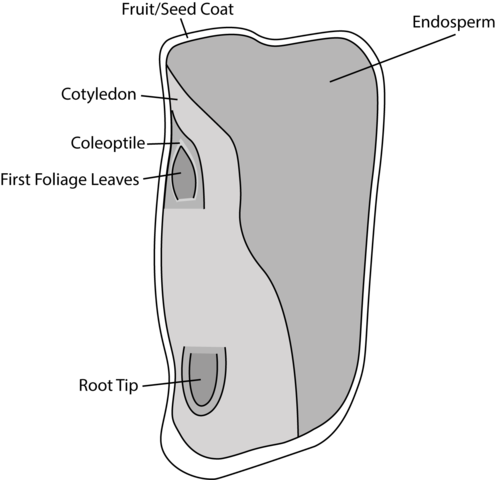
In grasses, like the corn in the illustration above, the endosperm is the major energy and nutrient storage tissue. This is different from the kidney bean, where the cotyledon is the storage organ. There is a cotyledon in the corn seed as well, but instead of storing energy and nutrients, it helps break down, absorb, and transfer the energy and nutrients stored in the endosperm to the embryo. Also in many monocots, there is a sheath covering the plumule and epicotyl that provides protection. This sheath is called the coleoptile. A similar sheath covers the radicle, and is called the coleorhiza. Coleoptile and coleorhiza are terms used specifically with plants in the grass family (Poaceae), and not in other families within monocots. Both function in providing protection to the emerging shoot and root. In the corn seed, the three functions of 1) propagation, 2) protection, and 3) nutrition are satisfied by the:
- Embryo (shown in this illustration extending from the shoot to the root) and that will propagate a new plant.
- Endosperm tissue that provides energy and nutrition for the embryo.
- Pericarp protecting everything inside. Remember that in corn, which produces a type of fruit called a caryopsis, the pericarp is fused right to the seed. The pericarp is the mature ovary wall of the female corn flower in the ear (labeled ‘seed coat’ in the illustration above).
This summary table contrasts corn and bean seed components:
| Cotyledon | Endosperm | Seed Coat | Pericarp | |
| Corn – monocot | Energy absorption | Energy storage | Remnants (these tissues are absent or only fragments of tissue in the mature seed) | Protection (outermost layer of the corn kernel) |
| Bean – dicot | Energy storage | Remnants (these tissues are absent or only fragments of tissue in the mature seed) | Protection (outermost layer of the bean seed) | Protection (pod) |
Second function: Storing energy and nutrients for embryo growth
Among flowering plants, energy and nutrients can be stored in the seed in the:
- Cotyledon
- Endosperm
What types of energy and nutrients are stored in these tissues? Think about the seeds you eat, and you can probably name many of these nutrients.
Carbohydrates
- Provide energy — complex molecules composed of carbon, hydrogen, oxygen.
- In plants, carbohydrates include starch and sugar.
Protein
- Sources of amino acids for production of enzymes and other nitrogen-rich compounds.
- Amino acids are the building blocks of proteins.
- Protein is the solid material in tofu (pressed curds from coagulated soy milk). There are several different categories of protein in seeds based on the specific chemical structures of the molecules. Gluten is a type of protein found in wheat endosperm that confers elasticity to bread dough so that the stretchy dough traps the carbon dioxide given off by yeast in the bread-making process and forms a tender loaf full of air pockets.
Lipids
Plant oils, called triglycerides, are compact molecules for storing energy in a more compact way than in starch and sugar.
We are bombarded with a great deal of confusing nutritional information about lipids in our foods. When you encounter nutritional claims, keep this information in mind:
 The building blocks of a triglyceride are a Glycerol molecule plus 3 Fatty Acids. The illustration shows a triglyceride made up of glycerol linked to three saturated fatty acids.
The building blocks of a triglyceride are a Glycerol molecule plus 3 Fatty Acids. The illustration shows a triglyceride made up of glycerol linked to three saturated fatty acids.- Fatty acids are long chains of carbon atoms with two hydrogen atoms attached to each carbon, except where there is a double bond between adjacent carbons on the chain. In the case of a double bond, each carbon involved in the double bond has only one attached hydrogen atom.
- Saturated fatty acids have no double bonds in the chain, and all carbon atoms in the interior of the chain have two attached hydrogen atoms — they are thus saturated with hydrogen atoms.
- Unsaturated fatty acids have one or more double bonds between one or more carbon atoms in the chain. These fatty acids lack some hydrogen atoms, and therefore the carbon atoms are not saturated with hydrogen — they are unsaturated.
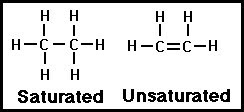
- You have probably heard nutritional claims about saturated and unsaturated fats. The difference between the two is whether all the carbon atoms in the fatty acids are saturated with hydrogen atoms, or are missing hydrogen atoms as a result of double bonds in the carbon chain. Plant oils tend to be unsaturated, which results in them being liquid at room temperature — they have a low melting point. Animal fats tend to be saturated, which results in them being solid at room temperature — they have a higher melting point. If you are interested in more of the chemical nature of fatty acids, check out this link to The Fat Primer (optional reading).
Nutrient differences between monocots and dicots (legumes in particular)
Dicots
As noted above, seeds with two cotyledons tend to have cotyledons whose function is storage. Legumes (Fabaceae family) like beans, peas, soybeans, and lentils are dicots that tend to store large amounts of protein in their cotyledons. Some legumes have high protein, high lipid, and low carbohydrates (like soybean and peanut); these are called oilseeds because they have high lipid content and oil can be squeezed or otherwise extracted from them. Others have high protein, low lipid, and high carbohydrate (like pea and bean), and these are called pulse crops. Pulse crops are hugely important foods because they are edible protein sources. They are a key source of protein in vegetarian diets.
Monocots
Monocots have a cotyledon too, but as noted earlier the cotyledon is primarily used for absorption. In cereals the endosperm stores the nutrients, which tend to be primarily starch and sugar and low amounts of protein and oil.
As a rule, legume seeds are high protein (and in some cases like soybean and peanut high oil), while cereal grains like corn, wheat, oats, barley, and rice are high in starch.
Review questions
- What seed structure(s) contains carbohydrates?
- What is the key characteristic of an unsaturated fatty acid?
Third function: Protecting the embryo and nutrients
Seeds have two layers of protection:
- The seed coat, which originates as ovule wall tissue.
- The pericarp, which originates as ovary wall tissue.
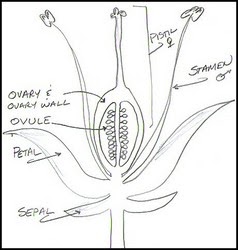
The line drawing of a flower cross-section, right, shows sepals, petals, stamens (made up of a filament and anther), and carpel or pistil (made up of stigma, style, and ovary). Also identified are the ovary wall and the ovule wall. The ovary is at the base of the carpel and holds the ovules. The ovules are protected by the ovary and hold the egg. When the flower is fertilized, a pollen tube germinates from the pollen grain and grows into the stigma and down through the style. The sperm follows the pollen tube into the ovary. One sperm unites with the egg and the resulting zygote becomes the embryo. The other sperm unites with two polar nuclei to form the endosperm. This is the double fertilization noted earlier.
As the seed matures, the cells inside the ovule multiply and grow. The ovule wall, which is made up of maternal cells called integument tissue, matures to become the seed coat. An example of a seed coat is the red or tan “skin” on a peanut. The ovary wall (note the important difference between the words “ovule” and “ovary”) matures into the protective cover called the pericarp. Again using peanut as an example, the pericarp is the “shell” of the peanut. So peanuts-in-the-shell are an example of a pericarp (shell, ovary wall tissue) and a seed coat (skin, ovule wall tissue) protecting the cotyledons and embryo within the seed.
In contrast, when corn matures, the ovule wall smashes up against the ovary wall as the cells inside multiply and enlarge. The ovule wall cells disintegrate, so at maturity there are only remnants of the seed coat. The ovary wall matures into the pericarp of the corn seed, which is the hard exterior of the seed.
These words belong together:
- Ovule wall — Seed coat
- Ovary wall — Pericarp
You might be interested to know that you are probably wearing integument/seed coat tissue right now. The fine fibers attached to the outside of cotton seeds are made up of long chains of single cells of integument tissue and are extensions of the seed coat. These fibers are removed from cotton seeds, spun into a fiber, and woven into fabric.
Review question
- When you eat green beans or snow peas as a (culinary) vegetable, are you eating pericarp, seed coat, or both?
Physical appearance of an organism.
Genetic composition of an organism.
Nascent (new, young) plant resulting from the combination of genes from the male sperm transmitted by the pollen to the female egg held in an ovule in the ovary.
A form of clonal reproduction where vegetative cells in the flower develop into zygotes to form seeds.
An embryonic leaf in seed-bearing plants, one or more of which are the first leaves to appear from a germinating seed.
Tissue that results from the second haploid male sperm cell fusing with two egg cells during fertilization.
Outer layer of the seed.
Embryonic root and shoot.
First true leaves of the plant and emerge from the seed, rise above the soil surface, and start to collect energy from the sun.
Where one haploid male sperm cell fuses with the female haploid egg cell to form the diploid zygote, and the second haploid male sperm cell fuses with two egg cells to form a triploid endosperm.
Protective sheath that covers in the plumule and epicotyl in the Poaceae family.
Protective sheath that covers the radicle in the Poaceae family.
One of the three major types of nutrients found in seeds; they provide energy in the form of starch and sugar.
Sources of amino acids for production of enzymes and other nitrogen-rich compounds in the seed.
Another name for lipids.
Compact plant oils that store energy; also called triglycerides.
Fatty acids that have no double bonds in the chain with all carbon atoms in the interior of the chain having 2 attached hydrogen atoms.
Fatty acids that have one or more double bonds between one or more carbon atoms in the chain, lack some hydrogen atoms, and therefore the carbon atoms are not saturated with hydrogen.
Ripened ovary wall and it is made-up of three parts: exocarp, mesocarp, and endocarp.

